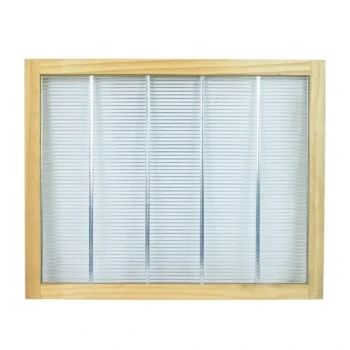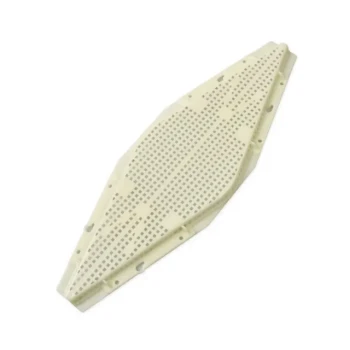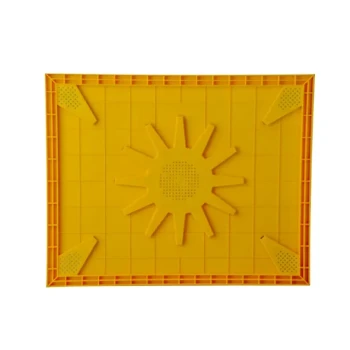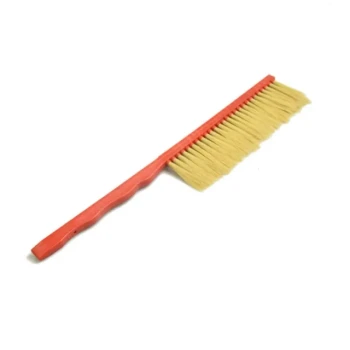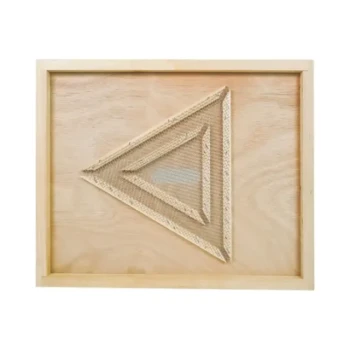For many beekeepers, a queen excluder is an essential tool that dramatically simplifies hive management and honey harvesting. It is a perforated grid placed between the hive's brood chamber and the honey storage boxes (supers). The holes are large enough for smaller worker bees to pass through but too small for the larger queen and drones, effectively confining the queen to the lower part of the hive.
The core value of a queen excluder is control. It establishes a clear boundary between the queen's egg-laying area and the honey storage area, which ensures cleaner honey harvesting and makes managing the colony more predictable.
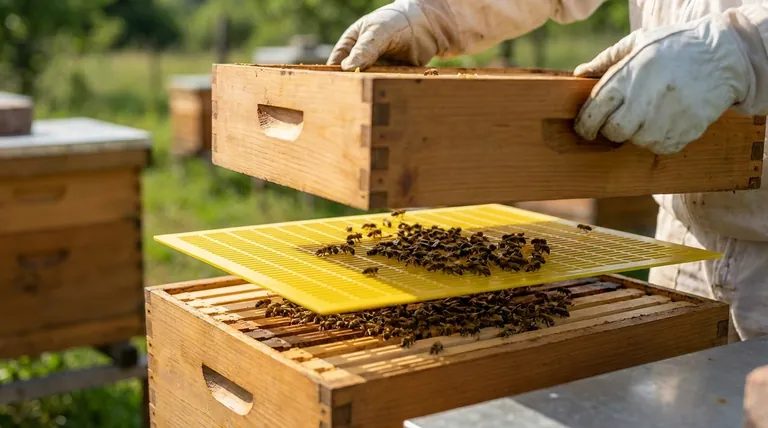
The Functional Role of a Queen Excluder
A queen excluder operates on a simple principle of size difference. It acts as a selective barrier, managing the queen's movement without significantly impeding the colony's primary workforce.
The Basic Principle: A Sieve for Bees
The grid or slots in an excluder are precisely sized to allow worker bees to move freely into the honey supers.
The queen bee, with her larger thorax, is physically blocked from passing through. This also prevents the bulky drones (male bees) from entering the honey supers.
Common Materials: Metal vs. Plastic
Excluders are typically made from metal wire or grids, or molded plastic. Metal excluders are valued for their durability and precise spacing, while plastic versions are lighter and more economical.
The Primary Benefits of Using an Excluder
Using an excluder is a strategic decision aimed at efficiency and organization. It provides several clear advantages for the beekeeper.
Ensuring Brood-Free Honey Supers
This is the most significant benefit. By keeping the queen in the brood chamber, you prevent her from laying eggs in the honey supers.
This means you can harvest frames of honey without worrying about damaging larvae or mixing brood into your final product. It also yields cleaner wax cappings for rendering.
Simplifying Hive Inspections
Knowing the queen is confined to the lower boxes makes finding her much easier. This is critical for tasks like checking her laying pattern or performing a requeening.
Instead of searching through the entire hive, you can focus your inspection on a known area, saving time and reducing disruption to the colony.
Managing Colony Growth
By limiting the queen's laying area, an excluder can help manage the overall population of the hive.
This can be a useful strategy in areas with Africanized bees to help control defensiveness or as part of an integrated pest management plan for controlling Varroa mite populations by restricting the amount of brood they can reproduce in.
Understanding the Trade-offs and Debates
While invaluable to many, queen excluders are not used by all beekeepers. It's important to understand the potential downsides to make an informed decision.
Potential for Reduced Honey Production
A common argument against excluders is that they create a barrier that can slow worker bees' movement into the supers. This "bottleneck" may lead to a less efficient honey-gathering process.
Some beekeepers also believe that workers are less inclined to cross the barrier, sometimes leading them to store nectar in the brood chamber instead of the supers.
The Risk of a "Honey-Bound" Brood Nest
If workers are reluctant to move through the excluder, they may begin to backfill empty cells in the brood chamber with nectar.
This reduces the space available for the queen to lay eggs, which can limit colony growth and, ultimately, the size of the foraging workforce. This requires active management by the beekeeper to ensure the queen always has adequate space.
Wear and Tear on Worker Bees
Some beekeepers, particularly those who use metal excluders, express concern that repeatedly squeezing through the grid can damage the delicate wings of worker bees over time, potentially shortening their lifespan.
Making the Right Choice for Your Goal
The decision to use a queen excluder depends entirely on your beekeeping philosophy and objectives. There is no single "correct" answer, only the best approach for your specific needs.
- If your primary focus is easy management and clean honey: The queen excluder is an invaluable tool that will simplify harvesting and hive inspections.
- If your primary focus is maximizing honey yield at all costs: You might experiment with not using an excluder, but be prepared for more intensive management to keep the queen out of the supers.
- If your primary focus is integrated pest management: A queen excluder can be a key component in a strategy to limit brood production and help control Varroa mite levels.
Ultimately, the queen excluder is a tool that offers greater control in exchange for slightly more intensive hive monitoring.
Summary Table:
| Aspect | With Excluder | Without Excluder |
|---|---|---|
| Honey Supers | Kept brood-free for clean harvest | Risk of brood contamination |
| Hive Inspection | Queen confined, easier to locate | Requires searching entire hive |
| Colony Growth | Controlled, helps manage pests | Unrestricted, can lead to swarming |
| Potential Drawback | Possible bottleneck for bees | Risk of honey-bound brood nest |
Maximize your apiary's efficiency and honey quality with the right equipment from HONESTBEE.
We supply durable, precision-engineered queen excluders and a full range of beekeeping supplies tailored for the needs of commercial apiaries and beekeeping equipment distributors. Our wholesale-focused operations ensure you get reliable, high-performance tools that simplify hive management and protect your harvest.
Contact HONESTBEE today to discuss your wholesale needs and discover how our equipment can strengthen your beekeeping operation.
Visual Guide
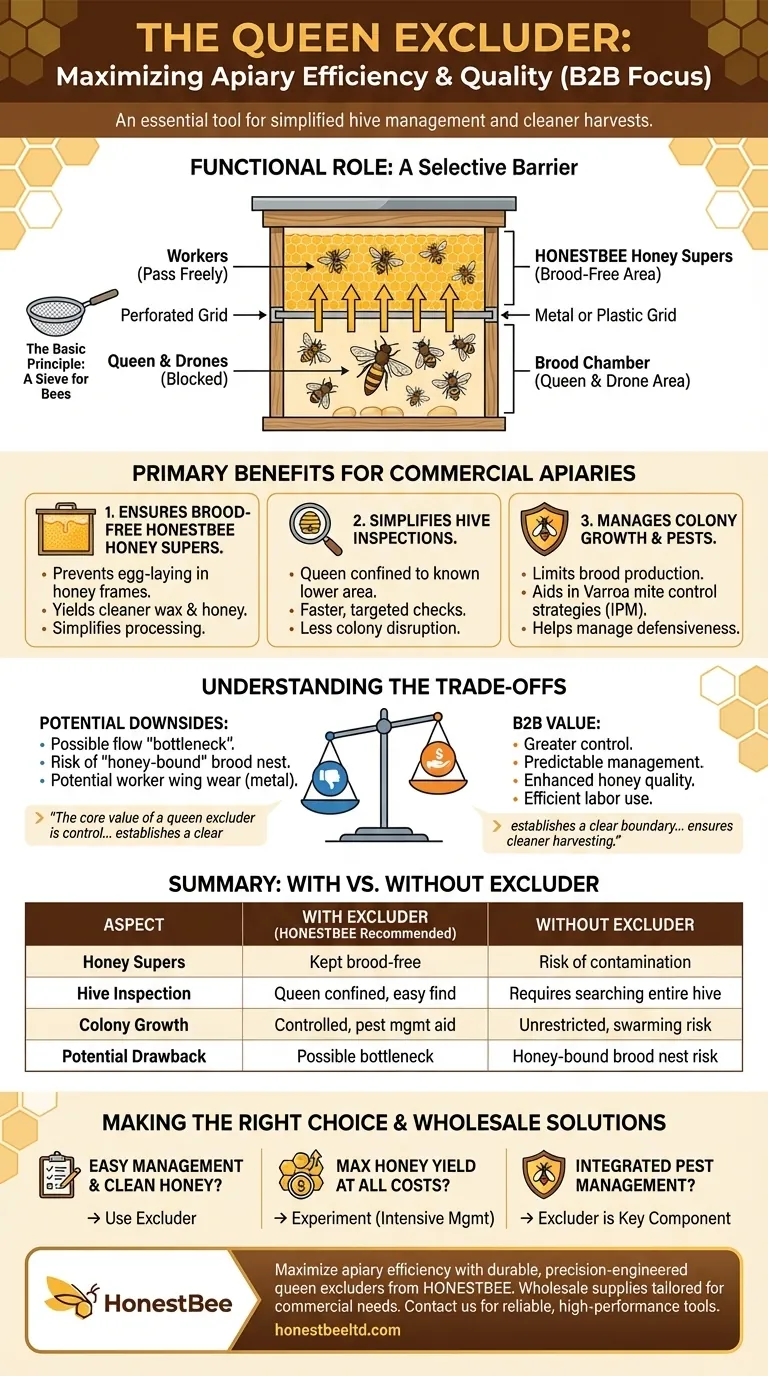
Related Products
- Professional Plastic Queen Excluder for Modern Beekeeping
- Premium Wood Framed Metal Wire Queen Bee Excluder
- Wooden Queen Bee Excluder for Beekeeping
- Plastic Queen Bee Excluder for Bee Hive Wholesale
- High Performance Plastic Queen Excluder for Beekeeping and Apiary Management
People Also Ask
- Why are queen excluders recommended for Flow Hives? Prevent Brood Damage for a Clean Harvest
- How does a queen excluder work? Master Hive Management for Pure Honey Harvests
- What is a Queen Excluder and how does it work? Achieve Purer Honey & Better Hive Control
- What are the main advantages of using a queen excluder in beekeeping? Simplify Hive Management & Harvest
- What is the primary function of a queen excluder in beekeeping? Control Hive Layout for Efficient Honey Harvesting

